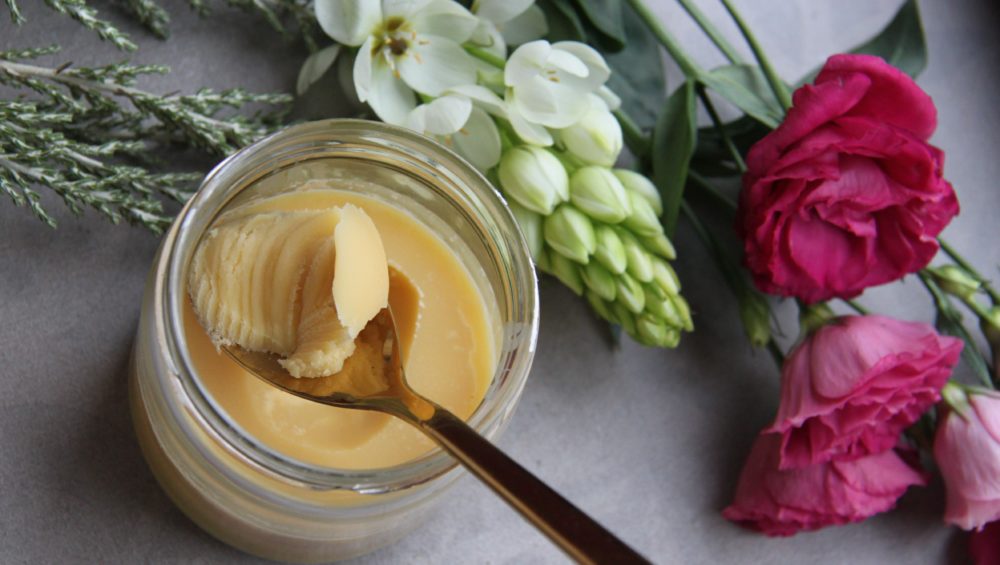Ghee is a staple cooking ingredient in every Indian household. It has a delicious nutty aroma and flavour and a high smoke point, making it very versatile. Try it out for yourself with this delicious gluten-free cookie recipe.
How to use ghee
Ghee can be used in place of butter or oil. It is perfect for roasting, sautéing and frying. It can also be drizzled over steamed vegetables. Ghee has a nutty flavour so it pairs well with eggs, pasta, lentils, seafoods, chicken and red meats. Ghee can also be used for desserts, like this Coconut Strawberry Basbousa. In India, ghee is commonly used with rice dishes such biryani. It is also often served along side unleavened bread like baati. Sometimes, ghee is brushed onto roti or naan breads, for extra flavour.
Ayurveda medicine suggests that ghee is best consumed in the morning, on an empty stomach. This is said to lubricate the joints, tissue and gastrointestinal tract. Ghee became popular in Western cultures as an ingredient in bulletproof coffee. Consumers of this keto-friendly drink say that the nutty flavour and creamy texture of ghee pairs perfectly with coffee. In addition to the taste, ghee provides healthy fats for energy and for satiating appetite.
What is ghee?
Ghee is a clarified butter, which means it has been simmered until the milk solids caramelise and separate from the oil. These solids are then strained off, leaving behind a thick, golden oil. It is stable at room temperature although, like coconut oil, it solidifies if the surroundings are cold. Ghee has a smoke point of about 240°C. Whereas the smoke point of butter is 150°C and extra virgin olive oil is 210°C.
Ghee vs butter
Ghee is thought to be healthier than conventional butter because it provides omega-3 essential fatty acids without the milk sugar (lactose) and milk protein (casein). These elements are more likely to aggravate the digestive system of anyone with dairy sensitivity. The omega-3 fatty acids found in ghee can prevent inflammation, therefore playing a role in protecting against heart disease, and improving immune and digestive function. Ghee also provides a good source of short-chain saturated fats, such as butyric acid. These short-chain saturated fat can help maintain or improve gut health.
Ghee is rich in vitamins A and E. It is also high in omega-6 fatty acid conjugated linoleic acid (CLA), which support eye, skin and heart health. Additionally, CLA may be helpful in preventing obesity and hypertension, as it has been shown to reduce body fat and boost muscle mass.
Ghee is also used in Ayurveda, India’s traditional medicine system, where it is known as ‘ghrita’. Practitioners of Ayurveda recommend ghee to patients for treating indigestion, impaired bile flow and fatigue.
Is ghee Vegan?
Ghee is not vegan. It is made by simmering butter, that has been sourced from the milk of cows, buffalos or goats. However, if you are following a vegan or vegetarian diet and want to avoid animal-derived foods, Niulife Vegan Coconut Ghee tastes very similar to regular ghee and has an almost identical texture.
Peanut Butter Protein Cookie Recipe

Ingredients
For the cookies:
- 20 g Coconut Flour
- 1tsp cacao
- 40g chocolate protein powder
- 1 tsp Coconut Sugar
- 50ml milk of choice eg. almond, oat, soy
- Extra 1-2 tablespoons milk of choice, to bind
- 1 tsp Niulife Coconut Cider Vinegar
- 20g Niulife Vegan Coconut Ghee, melted
For the filling:
- 20g chocolate protein powder
- 20g smooth peanut butter
- 40g cashews, soaked overnight in milk of choice, strained and processed in a food processor
Method
- Preheat oven to 180ºC, fanforced. Line a baking sheet with baking paper.
- Place coconut flour, cacao, chocolate protein powder and coconut sugar in a bowl and stir to combine.
- Fold in milk and vinegar, then mix in ghee.
- Using your hands, mould mixture into a dough and roll it into 12 evenly-sized balls. Place balls on baking sheet and flatten each into a cookie shape. Bake for 15-20 minutes.
- Meanwhile, make filling by whipping or blending the protein powder, peanut butter and cashews together, adding a little milk if necessary to adjust the consistency.
- Let cookies cool completely before sandwiching together with filling. Devour immediately, or keep in the fridge for up to seven days.






